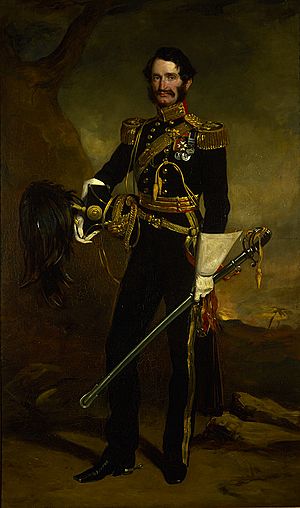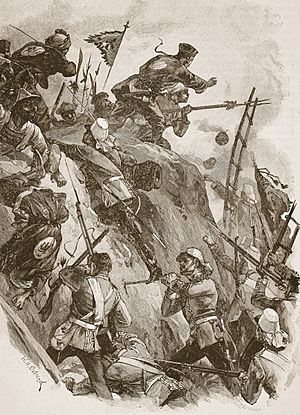Battle of Taku Forts (1860) facts for kids
Quick facts for kids Third Battle of Taku Forts |
|||||||
|---|---|---|---|---|---|---|---|
| Part of the Second Opium War | |||||||
|
|||||||
| Belligerents | |||||||
| Commanders and leaders | |||||||
| Strength | |||||||
| British: 10,000 infantry 1,000 cavalry:- Royal Dragoon Guards, Probyn's Horse, Fane's Horse French: 6,700 |
5,000 infantry, 2,000 cavalry ~45 artillery pieces, 4 forts |
||||||
| Casualties and losses | |||||||
| British: 201 French: 158 |
100+ killed, ~300 wounded, ~2,100 captured, 45 artillery pieces captured |
||||||
The Third Battle of Taku Forts was an important fight during the Second Opium War. It happened in 1860 when British and French forces went to China. The battle took place at the Taku Forts, which were strong forts near the city of Tianjin. These forts were about 60 kilometers (36 miles) southeast of Tianjin.
Why the Battle Happened
The British and French armies went to China to make the Chinese government in Peking (now Beijing) follow trade agreements. These agreements, signed in Tianjin in 1858, included letting the British continue the opium trade in China.
The British commander was Lieutenant-General Sir Hope Grant. The French commander was Lieutenant-General Charles Cousin-Montauban, Comte de Palikao. The combined British and French force had about 11,000 British soldiers, including 1,000 cavalry (soldiers on horseback). They also had 6,700 French troops. The Taku Forts were defended by about 7,000 Chinese soldiers from the Qing dynasty, with around 2,000 cavalry. The Chinese also had at least 45 artillery (large guns) defending the forts.
A year before this battle, the British and French tried to sail up the river. However, the Chinese had built a barrier across the river. This led to the Battle of Taku Forts (1859), which was a big loss for the British and French.
After that defeat, Captain Fisher of the Corps of Royal Engineers and three British ships stayed behind. They explored the land and coast to plan for the next attempt. More troops also became available after the Indian Mutiny ended, which helped strengthen the British forces in Hong Kong.
The Battle Begins
The British and French armies did not want to repeat their 1859 failure. So, on July 30, 1860, they started landing at Beitang, about 10 miles (16 km) north of the forts. A few days later, a small group went to scout the Taku Forts closely. Two British soldiers were shot and wounded by Chinese guns. By August 7, the entire force was on land. On August 12, the combined army began to advance.
The British and French pushed back Chinese forces, including about 2,000 cavalry. They soon reached the Taku Forts. There were four forts in total: two on the north side of the river and two on the south side. The French wanted to attack the southern forts. However, Captain Fisher's survey showed that the main northern fort was the most important one to capture. His plan was chosen on August 17.
During the night of August 20–21, five gun batteries were set up. These batteries were built using straw from nearby barracks.
- Battery 1: 6 French field-pieces (small cannons) and 1 large 8-inch gun.
- Battery 2: 3 large 8-inch mortars (guns that fire shells high into the air). The platform for this battery was made from coffin lids, which were 6 inches (15 cm) thick.
- Battery 3: 2 large 32-pounder guns and 2 8-inch howitzers (another type of cannon).
- Battery 4: 2 large 8-inch guns.
- Battery 5: 6 Armstrong guns (a type of powerful cannon).
The next morning, the guns opened fire. It took four hours to destroy the fort's artillery. Then, the main attack on the northern fort began. Two groups of soldiers, one British and one French, moved forward.
There was heavy fighting as the attackers crossed several Chinese ditches and spiky bamboo fences.
The British and French first tried to attack the main gate of the fort. But they found two wet ditches and many sharp spikes. An engineer managed to cut the ropes holding up the drawbridge. However, the bridge was too damaged by artillery to be used. So, the main attack was made against the walls using ladders. The French group managed to get onto the top of the wall first.
The first British officer to enter the fort was Lieutenant Robert Montresor Rogers. He was later given the Victoria Cross for his bravery that day. He was quickly followed by Private John McDougall, who also received the Victoria Cross. Lieutenants Nathaniel Burslem and Edmund Henry Lenon, Private Thomas Lane, and Ensign John Worthy Chaplin of the 67th Foot Hampshire Regiment also received the Victoria Cross for their courage. Fighting continued inside the fort for three and a half hours until all defenders were cleared out.
During the battle, fourteen British soldiers were killed, and Lieutenant Rogers was badly wounded. Forty-six other men were also wounded. The French forces had 158 casualties (killed or wounded). More than 100 Chinese defenders were killed, many more were wounded, and 45 guns were captured.
A white flag (a sign of truce) arrived by boat from a southern fort. But the British and French did not allow the envoy to negotiate. So, the combined force advanced. Two fresh regiments, The Buffs and the 8th Punjab Infantry, were brought up to attack the second northern fort in heavy rain. The Chinese offered little resistance, and this fort was quickly captured. The two southern forts could not be defended and soon surrendered.
What Happened Next
Seven Victoria Cross medals were given for bravery on August 21 to soldiers from the 44th Regiment of Foot and the 67th Regiment of Foot.
This battle was one of the last big fights of the Second Opium War. The river route to Peking was now open. The Chinese authorities surrendered all 22 forts along the river, including the town of Tianjin. The army then marched to the Battle of Palikao. The fighting ended when the British and French occupied Peking on October 13, 1860. After this, the Chinese finally accepted the trading agreements.



